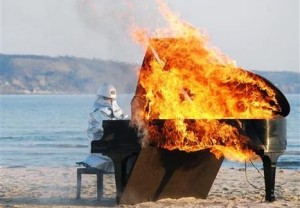 As with any new activity, being able to play the piano involves acquiring a balanced mixture of both knowledge and skill. Basic facts come easily, such as where the notes are on the keyboard and how they relate to each other. However, learning all of the intricacies of how music is written and played can take many years of study. Learning the necessary physical skills involving the hands and fingers takes plenty of time and practice as well.
As with any new activity, being able to play the piano involves acquiring a balanced mixture of both knowledge and skill. Basic facts come easily, such as where the notes are on the keyboard and how they relate to each other. However, learning all of the intricacies of how music is written and played can take many years of study. Learning the necessary physical skills involving the hands and fingers takes plenty of time and practice as well.
In the beginning, it is best not to jump in too far or too fast. Just as we learn to work with numbers first by recognizing them, then counting, then adding, then subtracting, then on to higher and more complicated problems, so too with music.
The first step is to study the keyboard and understand it well. There are seven notes, all in their own distinct places within the black key/white key pattern. This pattern is simply repeated up and down to form higher and lower pitches. Thus, if you learn a simple song, it may be played at higher and lower tones quite easily.
The next step in learning to play is to understand how the fingers are used. They are numbered 1 through 5 ( thumb, index, middle, ring, pinkie). It is important to remember when reading beginning music that the numbers may at first seem to always indicate a certain note on the piano, but this is only in the early stages and the student must never rely on a number to tell them what note to play. At some point, the beginner must study and practice reading music to be able to discern one written note from another. Numbers are used only to indicate which finger should be playing the note written.
As students begin to use their minds to understand the “rules” of music (how notes are written and songs composed) it is vital to develop skills with the hands/fingers. This requires much repetition – but the exercises do not have to be boring. On the contrary, learning finger skills can be very exciting in the beginning because many do not require the student to be able to read a single note of music. Thus the sounds produced may be very impressive coming from a new pianist!
In addition to the problem that many beginners have in believing that a finger number always indicates a certain note, many times an issue arises where the student , instead of truly reading the notes on the page, figures out a song’s melody (with much trial and error), memorizes it, then plays while watching the hands. Thus, it may seem that the student is progressing well when, in fact, they are taking a “short cut” that will eventually land them in a nasty rut! But, you may think, “What is so bad about a student being smart enough to find, learn, and memorize a melody? That sounds like a very impressive thing to me.” Let me explain that the practice is not inherently “bad”. It is however, an ability that may seriously hinder a student’s progress in learning to read music.
What can a teacher do to help students who have fallen into the highly undesirable habit of watching their hands when they play? My solution is to demonstrate how easy it is to play with the eyes closed. Most pupils do not believe themselves capable of this incredible feat – until, to their utter amazement, they try it out and discover that they are. Wow! What a confidence builder! Playing “blind” is a fun and exciting challenge for beginning students – and the perfect lead-in to some “piano logic”.
Fact 1: If you can play with your eyes shut tight, that means you do not have to watch your hands when you play.
Fact 2: If you do not have to watch your hands as you play, then you are able to keep those eyes on your music!
The students’ ability to be able to always keep their eyes on the music is crucial to their continued progress. If this skill is developed from the very beginning, the student and teacher will avoid much frustration in later lessons!
 Written by Julie Chapman - principal piano instructor for Piano Lessons with Julie.
Written by Julie Chapman - principal piano instructor for Piano Lessons with Julie. Piano Lessons with Julie provides affordable piano instruction for kids of all ages and is convenient to Woodstock Georgia and North Atlanta Georgia. You can find piano lesson rates and directions to piano teacher's home by clicking the links or just visiting the website - www.pianolessonswoodstock.com



